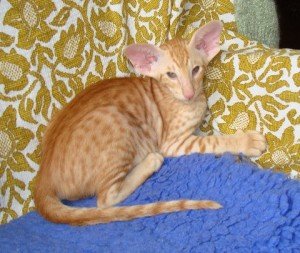The Oriental Varieties
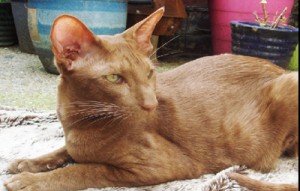 The GCCF divides Oriental Shorthairs into ‘Oriental Selfs’, ‘Oriental Non-Selfs other than Tabbies’, and ‘Oriental Tabbies’. The Oriental Selfs are the single colour cats the Black, Blue, Havana, Lilac, Cinnamon, Fawn, Caramel and also the Red, Cream & Apricot. The second group of Orientals consists of the Torties, Smokes and Shaded – they are neither self-coloured cats nor Tabbies; and the final group are the four patterns of Tabby.
The GCCF divides Oriental Shorthairs into ‘Oriental Selfs’, ‘Oriental Non-Selfs other than Tabbies’, and ‘Oriental Tabbies’. The Oriental Selfs are the single colour cats the Black, Blue, Havana, Lilac, Cinnamon, Fawn, Caramel and also the Red, Cream & Apricot. The second group of Orientals consists of the Torties, Smokes and Shaded – they are neither self-coloured cats nor Tabbies; and the final group are the four patterns of Tabby.
The Selfs
In addition to the ‘coloured’ cats there is of course another ‘Self’ variety, namely the Foreign White which is of a different genetic origin, and has the blue eye colour of the Siamese, indeed genetically it is a Siamese with an additional gene for white!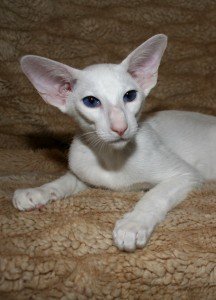
With the exception of the Foreign White all Orientals are of genotype CC or Ccs and show the full expression of coat colour. Genetically the Oriental and the Siamese are very close and visually, other than the body colour, the main difference is eye colour, for unlike the Siamese the Oriental has a green eye.
The GCCF Breed Standard states that the eye colour in the Oriental should be ‘Green with no flecks of contrasting colour’, though in the Havana & Lilac this is qualified as ‘Clear, bright vivid green’. In the Breed Standards for the Red, Cream and Apricot there is recognition of the difficulty in breeding clear green eye colour in the red series cats and the requirement is for the eyes to be ‘Any shade of green, the more vivid the better, with no flecks of contrasting colour’.
Though the Breed Standard states that the eye colour of the Oriental is green, the reality is that the eye colour of very many Orientals ranges from orange to yellow to yellowish-green and the desired clear green is seen in the minority of cats. It is the aim of all breeders to breed clear green eyes, but few breeders do so with consistency. Good eye colour makes all the difference between a ‘top winner’ and an ‘also ran’. There does not appear to be any logic to the inheritance of green eye colour and parents with perfect eye colour can produce kittens of very poor eye colour; and yellow-eyed parents will produce kittens with perfect eye colour!
The coat of the Oriental should be short and close lying and it is a requirement of all Oriental Self Breed Standards that the colour is sound to the roots, in other words extends right down to the roots. It is not enough just to look at the surface of the coat and this is why Judges pull back the coat and look at the roots. So important is this deemed that Judges are instructed to withhold Certificates or First Prizes in Kitten Open Classes where the colour is ‘unsound’ or does not extend right down to the skin.
One problem with Orientals is that they do enjoy lying in the sun, and it really does play havoc with their coats! Blacks and Blues develop rusty patches in their coats and the other colours show pale yellowish patches. The result of a Havana lying in the sun may well be a nice brown body with ginger ears and tail, and a poor Cinnamon becomes totally mottled ginger!
White markings anywhere in the coat of an Oriental, regardless of the colour or pattern, are totally unacceptable and Judges are instructed to withhold all awards from cats with white markings. The two most common places where white markings are likely to be found are on the neck under the chin, and in the middle of the tummy. Judges invariably refer to a white patch on the throat as a ‘locket’ and on the tummy as a ‘belly spot’.
The presence of scattered white hairs in the coat is also a serious fault, though not quite as bad as white spots, and Judges are instructed to withhold certificates or first prizes in Kitten Open Classes from animals showing this fault. The most likely places to find white hairs are on the throat, at the ‘bikini line’ on the tummy, between the hind legs and in the ‘armpits’.
It is not unknown for small kittens to be liberally peppered with long white guard hairs, it can be rather alarming for the breeder, but invariably these moult out when the kitten is five or six months old leaving a totally clear coat!
It must be borne in mind that in many cases hairs growing on the site of wounds and scar tissue may change colour, and it is not unusual to find speckled white hairs on the site of injuries. What then does the Judge do when confronted by a faultless female who has scattered white hairs around the back of her neck and between the shoulders? If the queen has obviously had several litters of kittens, then it is more than likely that the hairs are the result of an over amorous stud cat; should the Judge withhold the Certificate as directed by the Breed Standard, or should the exhibitor remove the offensive hairs? As a Judge and an exhibitor I have to say that in either situation the decision will always be between my conscience and me!
The Oriental Black and Blue
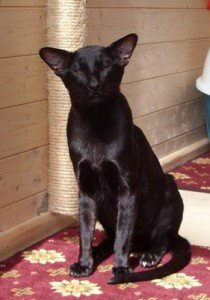 The Oriental Black is a totally black cat and the coat should be “Jet black to the roots” and should be free from any rusty tinge.
The Oriental Black is a totally black cat and the coat should be “Jet black to the roots” and should be free from any rusty tinge. 
Nose leather and eye rims are black, and paw pads are a dark brown to black. An Oriental Black with a really good short glossy coat will shine like polished ebony.
In the Oriental Blue the coat should be a ‘light to medium blue’ totally ‘free from silvery tipping’ or rusty tinge. The Nose Leather, eye rims and paw pads should be solid blue, though in kittens this may be rather pinkish blue.
The colour of the majority of Oriental Blues has always been too dark and is more ‘gunmetal’ in colour than ‘light to medium’ blue. It is quite possible that we are being unrealistic in asking for a ‘light to medium’ blue coat and at the same time asking for a short glossy coat. The Blue Persian has a long coat of soft powder blue and the British Blue has a medium length coat of mid-blue, the common factor is that there is the same amount of blue pigmentation in each type of hair. Spread over a long hair the colour is soft blue, and becomes darker in breeds with shorter hair, one does therefore have to question if in the Oriental Shorthair we can ever expect ‘light blue’.
The Havana and Oriental Lilac
The Breed Standard for the Havana asks that the coat is ‘rich warm chestnut brown’ which is neither dark nor cold toned. The nose leather, eye rims and paw pads are brown or pinkish-brown. There is no doubt that on the showbench there is a considerable range of colour in the Havana, and the majority fall within the range of acceptability, though there are some that are so dark they could almost be mistaken for black! The ideal coat colour in an adult has warmth and richness and is only sufficiently dark so that ghost markings are not immediately obvious.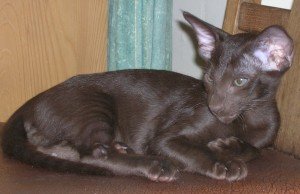
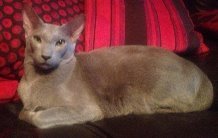
The Oriental Lilac is the dilute cousin of the Havana; the coat colour is described as ‘frosty grey with a distinct pinkish tone, giving an overall appearance of lilac’. It should not be too blue or too fawn in colour. The nose leather, eye rims, and paw pads should all be of a pinkish lilac colour.
Unfortunately many modern Oriental Lilacs are very cold and bluish in colour, lacking the soft pinkish hue that the standard requires. The correct lilac colour is very delicate and attractive. Of course it will show ghost markings to a greater or lesser degree, and this must be accepted.
Because so many Oriental Lilacs are rather dark or cold in colour they do cause confusion with the Oriental Caramel. A good lilac colour and a good caramel colour are distinctly different, but unfortunately where neither is of good colour the differences can be very slight.
Unlike the other Self Colours (excepting Red, Cream & Apricot) where the requirement is merely for the eyes to be ‘green’ the Breed Standard for the Havana & Foreign Lilac qualifies this and states that it should be ‘Clear, bright vivid green’. There can be no sight more beautiful than a richly coloured Havana with clear ‘grass green’ eyes!
The Oriental Cinnamon and Fawn
The GCCF Breed Standard describes the coat colour as being “Warm cinnamon brown, coloured to the roots”, the colour is a rich sandy brown with is far removed from the deep rich brown of the Havana. One of the problems with the Oriental Cinnamon is that the light coat shows ghost markings, and though some allowance has to be for this preference must be given to the clearest coats. The nose leather is Cinnamon brown, and the pads are pink to brown in colour.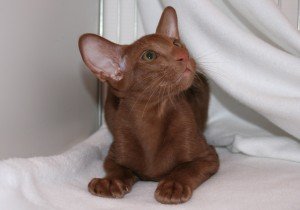
The Breed Standard for the Oriental Fawn describes the coat as being “Warm rosy mushroom, coloured to the roots. The pinker the better, colour too blue or cold is a fault”. A good coloured Fawn is a cat of great beauty and is much softer and more delicate in colour than even the best of the Oriental Lilacs. Again because the coat colour is so light there is a tendency for ghost markings. The nose leather and pads are described as “pinkish fawn”.
The ‘light brown’ gene which produces Cinnamon; and in combination with dilute, the Fawn; is recessive to the normal Chocolate Brown gene responsible for the production of the brown colouring seen in the Havana and Chocolate Point Siamese, and can accordingly be carried by cats of the normal brown or lilac colour, or indeed any other colour. One cannot detect visually which Havanas or Orientals may carry the recessive ‘light brown’ allele; but two such Havanas mated together will produce both the normal brown cat, and the ‘light brown’ cat.
The Oriental Caramel
The Oriental Caramel is regarded by many as being rather dull drab in colour, and was the last variety to gain Championship status.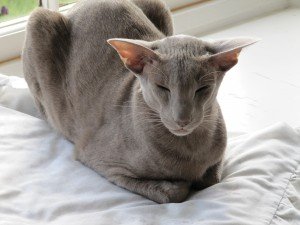
The Caramel colour is the result of the action of a dominant gene known as the ‘Dilute Modifier’ (Dm) on Blue, Lilac and Fawn. Current theory is that the presence of the Dilute Modifier gene converts Blue, Lilac and Fawn. There are visible differences between the three Caramel genotypes, especially in the Tabby forms, but they are really quite subtle. The Breed Standard recognized the differences in colour and describes the coat colour as “Dark brownish grey (for blue based) or a warmer brownish grey (for lilac/fawn based), coloured to the roots. All caramels should display a metallic sheen irrespective of their colour base, but may be less evident in kittens. “
The distinctive metallic, aluminium like sheen, which is particularly visible across the neck and top of head is a hallmark of the variety, though in the Self form is often not very obvious unless the animal has heavy ghost markings. In the Tabby and Shaded forms it is very distinct.
Though the Dilute Modifier gene is a dominant gene it can be carried by Black, Chocolate, Cinnamon and Red cats, plus of course Black, Chocolate and Cinnamon Torties without in any way affecting the appearance of their colour. To all intents and purposes the gene lurks undetected, until of course Caramel or Apricot kittens arrive!
The Foreign White
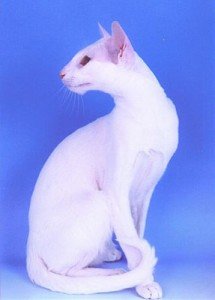 The Foreign White must surely be the most elegant of the Orientals, with a look as delicate as porcelain. The coat must be the cleanest and clearest of whites and have the sparkle of purest snow, add to this the clean pink nose and royal blue eyes and many have fallen under their spell. The Foreign White is the most ethereal of breeds!
The Foreign White must surely be the most elegant of the Orientals, with a look as delicate as porcelain. The coat must be the cleanest and clearest of whites and have the sparkle of purest snow, add to this the clean pink nose and royal blue eyes and many have fallen under their spell. The Foreign White is the most ethereal of breeds!
The Foreign White is one of the few Oriental to have blue eye colour instead of green. The other variety which also has blue eye colour is the Pointed Bi-Colour.
Foreign White kittens will often show a ‘smudge’ of colour on the top of their head, and though the Breed Standard makes no mention, the majority of Judges will totally disregard this recognizing it as a sign that the kitten is unlikely to be deaf. Deafness is a common problem in White cats, but something that the Foreign White is fairly free from. The coloured ‘smudge’ is a transitory thing and will have disappeared by the time the kitten is adult.
The GCCF does not recognise the green eyed ‘Oriental White’.
The Oriental Red, Cream and Apricot
The inheritance of red colour in the cat is highly unusual in that it is ‘sex-linked’. The ‘red’ colour is carried on a sex chromosome and results not only in the mosaic pattern of the tortoiseshell, but also the specific relationship between gender and colour.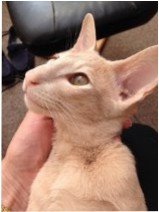
The gene responsible for red (‘orange’) colour is carried on the X chromosome and is symbolised ‘O’ for ‘Orange’. A male cat, being XY, can therefore only have one gene for red colour, and is therefore either ‘O’ or ‘o’, whereas the female, being XX, will have two genes and therefore have genotype OO, Oo or oo. Cats of genotype ‘O’ and ‘OO’ will be Red, Cream or Apricot in colour dependant on their remaining genotype. Cats of ‘o’ and ‘oo’ will not be in possession of any red colour, and those cats of genotype ‘Oo’ are the tortoiseshells, or torties, which are a mixture of both red and non-red colour and again the exact colour will be determined by the remainder of their genotype.
A further peculiarity of the red series cats is the ‘masking’ effect of the ‘O’ gene, which converts the normally black pigmentation to ‘orange’ or red pigmentation and completely masks the effects of the agouti and non-agouti genes. The result is that it is impossible to differentiate VISUALLY between a Red Self and a Red Tabby cat – they are identical and both appear to be RED TABBY! The GCCF Breed Standard takes cognizance of this and the colour descriptions of Red, Cream and Apricot states that “Tabby markings may be evident, especially in kittens, and should not penalise an otherwise good cat”. The GCCF registers all red, cream and apricot kittens from a mating where either parent is Agouti as agouti kittens.
The colour of red varies greatly in the cat, and the ideal colour in a show cat is far removed from the average ‘ginger’ or ‘marmalade’ moggy. The depth or intensity of colour is not determined entirely by the ‘O’ gene, or indeed by the masked base colour, but is the result of the action of polygenes. Some polygenes or ‘enhancers’ affect the richness and depth of colour and this effect is often referred to as ‘rufism’. In Chocolate, Cinnamon and the red series selection for the effect of these polygenes is essential – in their absence the colours will lack warmth and be a poor relation of the best colour form. The Apricots are of course Creams that also have the Dilute Modifier (Dm) gene in their makeup; by and large they are an attractive colour. The Apricot is a slightly more intense colour than the Cream and usually has a hotter flush to it. Like the Caramel the Apricot invariably has a metallic sheen especially over the head; this must not be confused with the powdery effect of a good coloured cream!
